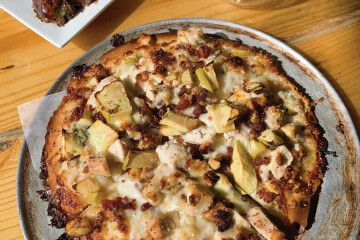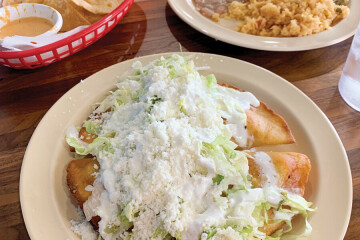Dean’s Zesty Booch
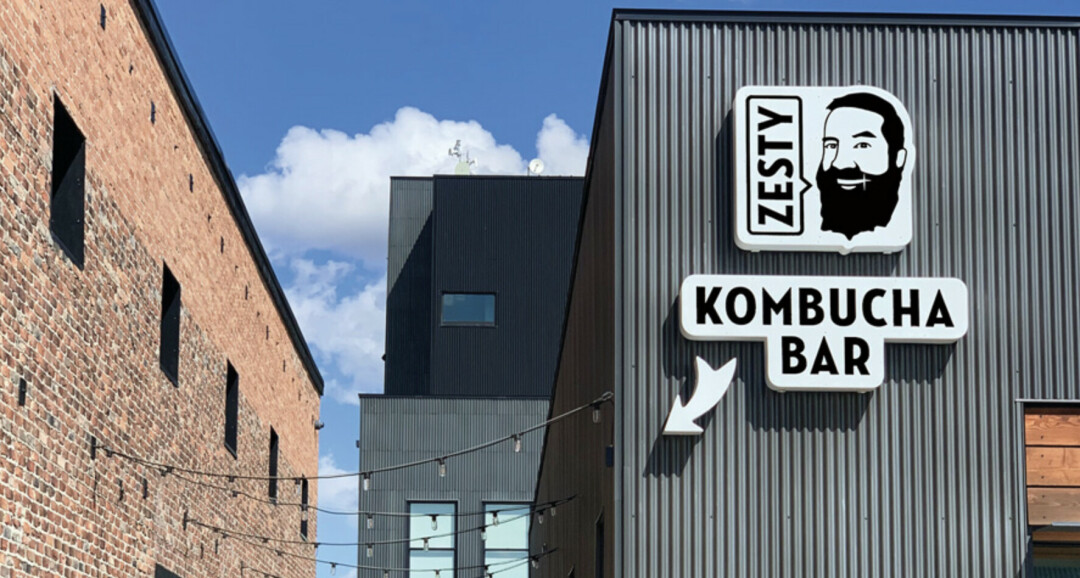
Dean’s Zesty Booch is revolutionizing the beverage scene one refreshing and delicious can of kombucha at a time. Their alcoholic and nonalcoholic kombucha seltzers offer a nutritionally dense, healthier drink alternative without sacrificing taste or experience. I joined partner and CEO John Griffith on the sunny patio to crack open a can, banter with the neighbors at Wildrye, and talk all things Zesty Booch.
Elsa Russell: How was Dean’s Zesty Booch conceptualized?
John Griffin: It started with my two co-founders. Dean began making kombucha in his kitchen. He got a starter culture from a classmate at yoga, a fairly typical kombucha founder story, and he started making this product that really built this cult following around town. It tasted unlike anything most people had tasted from kombucha at that time.
He and Joe met through the local music scene, and Joe saw it as something that could be commercially viable. He came up with the branding and traced Dean’s face, like you see up there on the sign. That was probably in like, gosh, 2010, 11, 12? Around that time. And then they started working on putting together a business plan and figuring out where the location was going to be. They settled on The Cannery District and started the shop in 2016. And then I got involved.
I went to Colorado State University for microbiology. While I was down there, I did a lot of home brewing and began taking some courses in fermentation sciences, so I’d been making beer and wine for a while. And then I was in grad school over here at MSU and I was drinking a lot of Kombucha. And I was like, “Well, shoot, this seems like something I can probably make pretty easily,” so I reached out within my network to find the starter culture, and through that wound up meeting Dean.
I came over here one day in 2014, and Dean was in here building out the bar. We kind of hit it off. I just came to introduce myself and we just sort of became buddies, and I was like, “Hey man, if you guys need help when the brewery opens up, I’ve got a micro degree and you know, I can wash kegs, whatever.”
So, we just kept that relationship open, and when the bar opened up in 2016, I started coming and hanging out and just sort of being the barfly. I started kind of interjecting my thoughts and opinions on how they could work on quality control and consistency, and just offered some constructive criticism in the brewing process. Before too long, it seemed pretty reasonable that we all just partner together.
So, I got involved as a partner in August, and at that point we were just a taproom. We weren’t doing any kind of distribution really, a little bit maybe to Seven, but we hadn’t figured out what it took to do distribution. So, we kind of grew from this really localcentric, community-centered sort of vibe; just servicing the local Bozeman Community. We started getting interest from bars and restaurants to carry kegs and that kind of thing, so we were just distributing around town.
We always wanted to go into some kind of portable to-go packaging. We started with little plastic bottles, and then we went to little glass bottles, and it was very DIY, just pulling things off the tap.
I think Lot G was probably our first customer to have any kind of packaging besides kegs. And then at that point, we were like, “Okay, this glass plastic thing, it is what it is, but we really want to be in cans.” We found out about this cidery in Oregon called Reverend Nats that had built this DIY bottling line, and we figured it shouldn’t be that difficult to turn that into DIY canning.
So, we built this canning line out of the siding that you put on your house. It was, like, draft parts and soffit board. It wasn’t the most efficient, but it was effective at kind of proving the concept. We did like a hundred thousand cans on that thing, one can at a time. It was really cumbersome, as you can imagine. We were basically sitting in the walk-in all day. We could do 40 cases or so in a day with four people, and through that, we began to really broaden the distribution footprint.
We started getting into Big Sky and Livingston and Belgrade, and I think we even had an account or two in Helena at that point that we were driving to. We did that for almost a year. The goal was to be automated by Christmas of 2019.
With all of the extra distribution, we were able to sign on with a statewide distributor. They began to take our products further, so at that point we were fairly confident that we could invest in an automated line. We got the automated canner in here in September of 2019, besting our plans by three months or so. Once that happened, we really just put the screws to it and started going all over the state in a really meaningful way.
It really took us a year or so to figure out exactly what flavors everybody wanted, and we were R&D-ing the alcohol products during that time too. We went to Kombucha Kon in 2017, which is like the industry conference. There was a hard kombucha in 2017, and hard kombucha wasn’t really on the radar at all. So, we saw that as an opportunity and saw that there was some room for improvement over the product that was out there, so we started digging into that.
By 2019, we’d settled on a couple flavors that seemed to really resonate with folks. And at that point, once we’d dialed all of the canning and the production stuff, we were figuring out our supply chain, figuring out where to get fruit, how to make the product in a timely fashion, all that stuff. We didn’t know how to do any of that, so we had to learn kind of trial by fire and through working with other brewers around the area and the country, figuring out what exactly makes a quality product in a can. It took us a while to figure all that out.
We got it pretty well dialed to the point where we set out in 2020 to launch nationwide distribution, or at least begin figuring out who we were going to partner with to make that all happen. We planned on doing that in March of 2020. Nobody knew what was coming down the pipeline at that point. And, you know, everything shuts down and we were just like, “Well, we’re not going to let that derail our plans.”
So, we just kept getting after it. We sent samples out all over the country, we had all kinds of phone call meetings with distributors all over the place, which was actually a benefit because the original plan was that I was going to be flying. 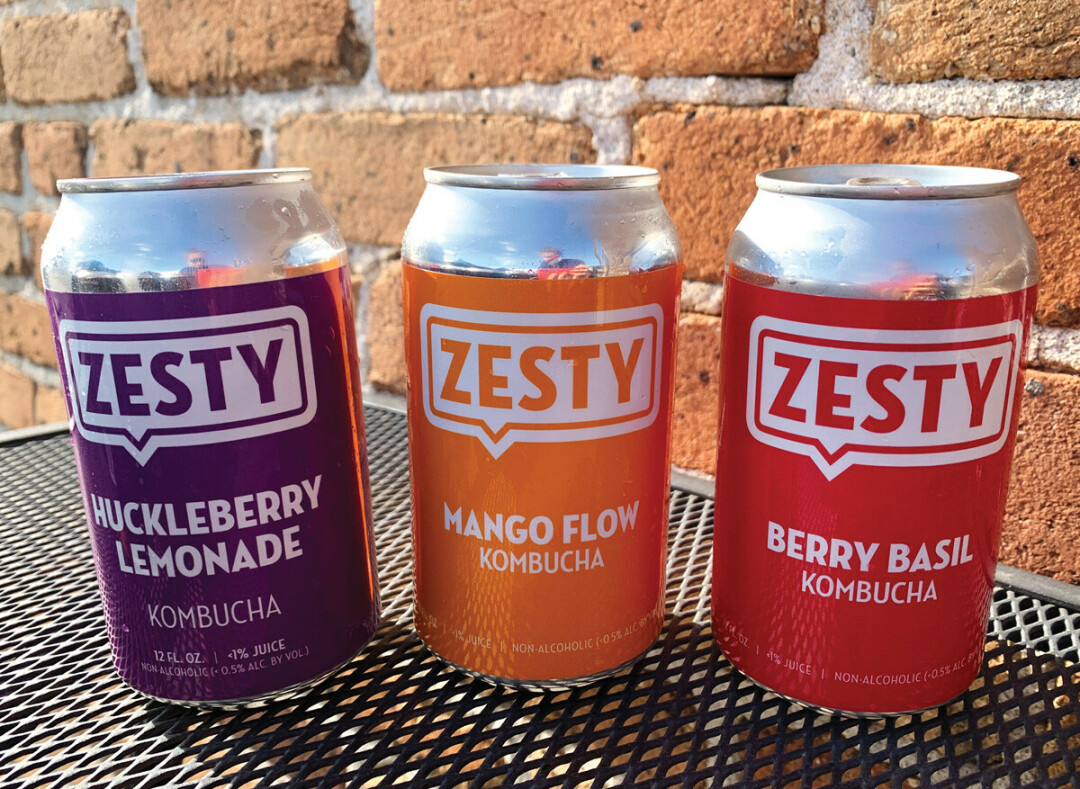
We didn’t get a ton of sales like that, but we got a lot of good feedback and we began to really understand what it is that larger distributors are looking for, and then specifically what big retailers are looking for, because up to that point we were over-indexed in restaurants and bars. We weren’t seeing a lot of sales through grocery at that point. And then, you know, nobody went to bars and restaurants anymore and everybody was in grocery stores and so, we were like, “Okay, we need to react really quickly to this.”
We wound up running incentive programs with our distributor in Montana, and they just crushed it and got us into all kinds of grocery stores. And then we learned how to navigate that system pretty well too. So, a lot of what I do now is working with chain accounts across the country, working with the buyers at large grocery stores, convenience, stores, etc., figuring out how to place the product, get it into their sets, stuff like that.
I think one of the really big tipping points for us was when we found out that Whole Foods was coming to Bozeman. We set a goal to be in that store the day they opened. I figured out who to talk to, and we had a small little sales team that we were working with. So, we reached out to the Whole Foods buyer for the Rocky Mountain region, which is like Colorado, Kansas, Utah, soon to be Montana, now Jackson Hole, Wyoming. So, they’re all kind of siloed. So, we found out who that buyer was and we put together a pitch deck. We pitched to him and he was like, “Yeah, let’s bring it in.” And once we were in Whole Foods, distributors were like “Yeah, we’ll work with you.”
So that really was kind of the tipping point for figuring out where this product is going to work best, how we get it outside of the state, and where we start. As opposed to trying to do the slow burn that we did in Montana and replicate that in other states, we figured we’d just go right for the biggest and best accounts that we could in some of those larger states. So that’s kind of where we are now.
While all that was happening over the last year, we had to shut down the retail component of our taproom. We used to be totally focused on filling up growlers, and people would come to the bar and hang out and have a drink or whatever. We had to shut that down, which is pretty sad, because I’ve met some of my closest friends through this bar. You know, some customers that have been just so instrumental in getting us to where we are. And we don’t have the ability to do that anymore. But we switched the format from this, you know, kind of single serve retail operation, to really digging into manufacturing philosophy and understanding how we make this product, how to manage our supply chain and cash flow, and how to do this on a big scale but with a small team.
That was, like, the best thing that came out of everything that happened last year; we just dialed our system. We became a high-functioning team. Everybody that’s on board with us is super committed to what they do and stoked to be here, and while it took away some of the things that we really loved about what we were doing here, it also made us a stronger enterprise. So that’s where we’re at right now.
ER: What do you want people to experience when they walk through your doors?
JG: Walking through the doors right now, if you’ve never been in there, I think it can be a little bit intimidating. It’s kind of like a factory when you walk in now. And as you saw, you had to kind of weave your way through pallets of cans and stuff.
But we’re still welcoming. We still want you to come in and say hi, and we’ll still have you hang out for a little while, and hopefully you walk away with a really great experience. It’s the same thing we wanted to offer people when we were a retail operation. It’s all about a world-class beverage experience. At the end of the day, that’s what we want you to have and that’s what we’ll always figure out how to give people.
ER: What makes you unique in the Bozeman food and beverage scene?
JG: So Montana, you know, bless its heart. I love this state, it’s phenomenal, but it’s catching up to the rest of the country in terms of culinary and beverage. Most of the movement in the food and beverage scene here is being driven by Bozeman, Missoula, and the Flathead to a lesser extent. It’s still far behind what a lot of other parts of the country are experiencing. When you go to some of these centers of consumer-packaged goods like Colorado or California, even places down south, the beverage selection is so impressive. It’s inspiring as a beverage producer to go down there and see all these things around. As a beverage consumer, it can be overwhelming, you know? Because there are all these drinks and food products in some of these other states. Montana isn’t quite there. Like I said, we have these little pockets. So we’ve had to really put a lot of effort into building the awareness of what this is.
And so, I think, from the Montana Brewery scene standpoint, we were the first people doing any kind of hard seltzer in Montana. Definitely the first people doing hoppy hard seltzers in Montana, and certainly the first people doing hard kombucha here. We attempt to bring a culinary bent/ beer inspired/ cocktail inspired approach to this, while certainly trying to make it approachable and accessible. We’re still trying to do things that might be a little ahead of their time for this state. But not for long. There’s a thriving culinary scene in Montana. There are some incredible brewers.
There are a lot of people that are really working to build this state up in the eyes of the tastemakers of the world. And so, I don’t think that we’re necessarily all that different from a lot of the other breweries around here that are trying to push the scene forward, like Mountains Walking or BoZone with their underground program. There are some breweries around the state that are definitely moving nationwide beer forward.
But I think what we offer is a gluten-free, lower sugar, lower carb iteration, essentially trying to give people something that’s better for them without them having to sacrifice. Yeah, you know, like, it’s not like eating kale.
So that’s the idea. How do we provide these better-for-you alternatives, but make it seem like you’re not losing anything by enjoying them?
ER: What do your regulars keep coming back for?
JG: Well, it seems the ginger lemon has really run away with popularity in the alcoholic set. We just launched huckleberry lemonade in the non-alc family, and tons of people are really, really grabbing onto that.
Beyond just a flavor, I think people keep coming back because we’ve shown them that we can be consistent, that they can trust us to get the same product that they would get out of our taproom in Whitefish, or hopefully Billings one day. Billings has been a tough one. But I think that’s why people keep coming back. We’ve built those relationships over the last five years, and when people come in, we’re stoked to see them. Those relationships have been carried through for years. And cost, quality and delivery, at the end of the day? That’s what customers want and that’s what we try to provide.
ER: What do you enjoy most about being part of the Bozeman Community?
JG: We share some really great relationships with a lot of the other brewers in this area, not just in Bozeman, but around the state. But particularly in Bozeman, there are three brewers in particular that have been involved in some way, shape, or form in Zesty since nearly the beginning of its inception.
The first one was 406 Brewing. Matt Muth at 406, since before we even had this brewery, was letting us brew stuff in his space out front in the Cannery District. And as we began growing, he was an instrumental friend, consiglieri, consultant, all of it. He really helped us in a lot of ways, because I didn’t know how to carbonate beverages and stuff like that, or even how to use a pump to move around from tank to tank. He really helped us get all that stuff off the ground.
Then the Bozone has just been, again, the same sort of relationship. We have almost a partnership with them. We trade a lot of things with one another, whether it be storage space, case flats, pack text, all packaging stuff, knowledge, friendship, all of that stuff. And the same thing with Mountains Walking.
Those three folks to me are what solidifies not just the Bozeman brewing scene, but the brewing scene in general across the country. It’s why I wanted to get into this, because of that level of camaraderie. And so, I think that’s my favorite part about being a part of this; those partnerships, strategic or just friendly, that we’ve been fortunate enough to build through having this. That’s the best part.
Not to mention these guys (motions to Wildrye); we wouldn’t be able to make anything without them. We have a very long-standing friendship with Wildrye and that will continue into the future, whether or not they want it to.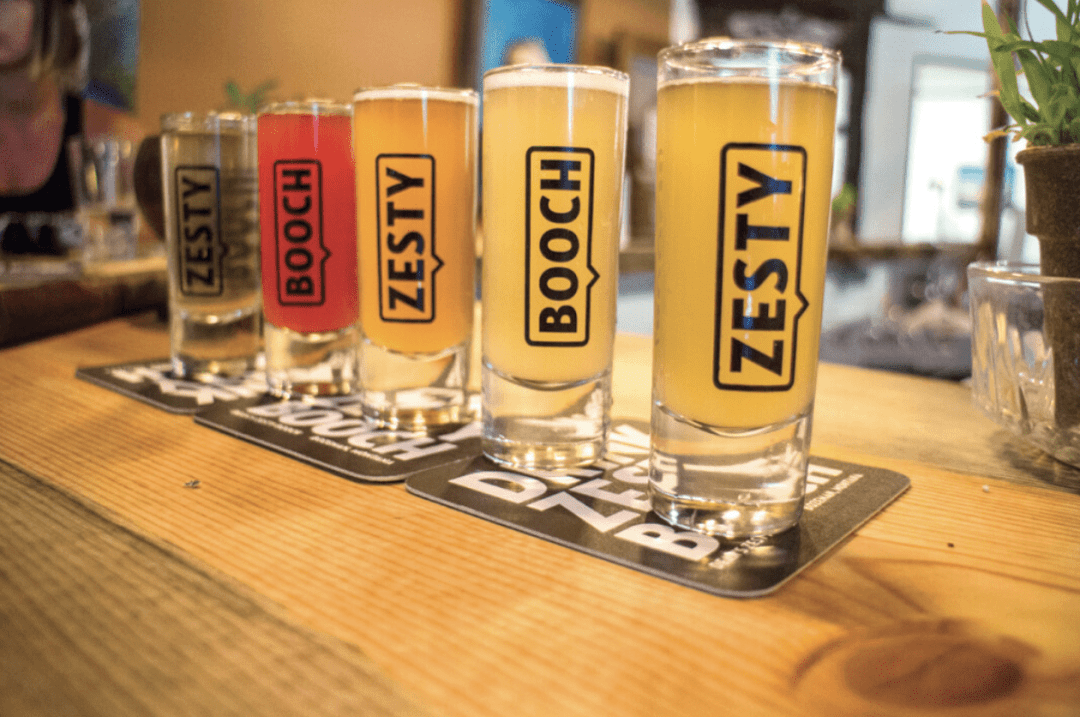
ER: Do you have anything coming up that you want readers to know about?
JG: Yeah, we’ve got a lot of fun things coming up. This summer, we’re about to move into Wyoming, Minnesota, The Dakotas, Utah, and Idaho. And so, while that may not be of interest to Bozeman readers in particular, what it does show is that we’re trying to build, and we’re trying to do our small part to give Bozeman the credit that it really deserves. Besides just being a beautiful geographic space to come see, there are really cool things happening in food and beverage in this state.
In terms of what we’re doing in Montana this year, we’ve got a handful of beer fests that we’re participating in. And summer of 2022, we will be doing Zest Fest. We did Montana Funk Fest in 2019, and we realized that we missed an opportunity to call it the Zest Fest. The idea behind it was to bring together all of the Montana kombucha producers. And then it kind of expanded from that initial idea to include all these other rad folks that are making sour beers and all these other funky alcoholic beverages.
So, we did Montana’s first sour beer festival. It was out back here on our patio. During the day, it was a big beer festival; we had like 14 brewers from around the state. And then we had a big concert afterwards with this band called The Floozies that are like this EDM funk rock band. They’re awesome. It was so much fun. And overall, the gig was a total success.
We want to recreate that in 2022, so that’ll happen out here. We’re doing the Big Sky PBR Rodeo too. We’re doing a lot of stuff with that, really trying to bring this beverage to a wider audience, so focusing on things like PBR, digging in a lot of hunting and fishing folks, really just expanding who wants to drink this.
That’s the future for us, taking kombucha away from being a niche beverage and turning it into something that anybody likes. I know it’s there, and I think we have a lot of people who you would not consider to be your stereotypical kombucha drinker.
We’ve figured out how to appeal to a wider palette, so it doesn’t just get lumped into like, “Oh, it’s a health food, it must not be good, it must not taste good.” It’s a stereotype that needs to be broken down.
Our mission is to unfuck the standard American diet. I don’t know if you can put that in there. It’s a lofty goal, but we do it by making beverages with fewer calories, more nutrients, and real food. That’s something that I think the country needs.
I don’t want to say we made these hard kombucha seltzers in response to seeing what happened with White Claw, but that was, to us, this beacon that people are ready for something different than beer. Craft beer saw this non-stop rise over the last 20 years, and it started to taper off because people got palette fatigue. People wanted something lighter. People deserve something lighter like White Claw, lower calories, lower carbs. But do they not also deserve some functionality to that beverage besides getting drunk?
The secret is out. Kombucha is taking the beverage world by storm, and for good reason. You can try Dean’s Zesty Booch for yourself at their taproom in the Cannery District, or find it at a number of local restaurants and grocery stores. Cheers!

